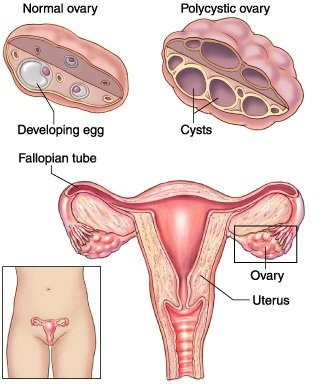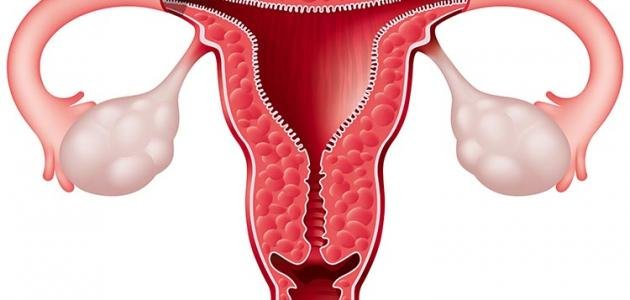
has many symptoms such as hyperthyroidism, obesity, acne, pregnancy problems and many more. See below for treatment methods:
The ovaries secrete two types of hormones that affect the female reproductive system:
Estrogen is the hormone responsible for the proper development of secondary sex markers in teenage girls, as well as for the maturation and normal physiological functions of the female reproductive system.
Progesterone is responsible with estrogen for periodic changes in menstrual cycle in females. This involves changing the envelope of the egg follicle in order to break it and release the egg during the ovulation phase as well as in increasing the temperature of the body after the ovulation process in order to create optimal conditions for meeting the egg and sperm.
Ovary
The ovary is the glanda (the organ that produces sexual cells) in females. Most oocytes are produced in the prenatal ovary. These oocytes are kept in the ovaries in their immature form until the fertility period. In the fertility period, the eggs mature within the egg follicle within approximately 28 days until ovulation. Ovulation usually occurs in only one egg in each cycle and alternates ovaries between them on the ovulation process in each cycle (once on the right and once on the left). In cases of ovarian insufficiency, due to ovarian disease or physical injury in one ovary, the healthy ovary takes on the role of developing follicle and ovulation each month.
What is PCOS?
PCOS is a satisfactory syndrome involving a number of different systems including the reproductive system, metabolic system, vascular system, heart, skin and hair. PCOS is one common problem among women of childbearing age.
A large proportion of women with one of the hallmarks of PCOS, such as infertility due to ovulation problems, obesity, hyperthyroidism, interruption of the cycle or oligomenorrhea, have the same syndrome.
There is still controversy over the exact definition of PCOS. Only recently has been clearly recognized in the contribution of the irregularity of the secretion and absorption of insulin mechanisms affected by the devices involved in the occurrence of this phenomenon.
PCOS is often characterized by a genetic disorder (not yet explained) at the family level. Due to the high incidence of PCOS among women in the family (a 50% probability of having a polycystic ovary).
Symptoms of PCOS
Symptoms of PCOS include the following (or some) signs:
High levels of masculine hormones - androgens
A thick-coated bleach containing many cysts (fluid-filled objects).
Menopause and menopause (Amenorrhea) - About 90%, of whom about 70% suffer from fertility problems.
High resistance to insulin (signs of diabetes), and accompanying metabolic problems - about 90%.
Obesity - about 40%.
Hyperthyroidism in the face, body and hair thinning - about 50%.
Acne - about 40%.
Cardiovascular damage due to high levels of triglycerides and low HDL (good cholesterol).
Increased risk of incomplete pregnancy (if pregnancy occurs).
Polycystic Ovary Syndrome
Treatment of polycystic ovaries

Treatment of polycystic ovaries
Treatment of symptoms associated with polycystic ovaries is usually treated in these ways:
Follow a healthy diet. Keeping weight and losing it - one of the best things you can do: Makes your menstrual periods more natural, and can also reduce hair growth and depression.
Exercise. Regularly and permanently-practicing exercises that help pump your heart, as well as lifting weights to keep your muscles strong.
get your medicine. To help relieve symptoms and achieve hormonal balance. This treatment can reduce and relieve acute symptoms and help prevent long-term potential diseases as well as acne treatment medications.
Getting rid of excess hair. You can try medical creams to get rid of excess hair, and you can remove excess hair forever by electrolytes or laser treatment.
Herbal Remedies.
It is important to undergo continuous medical monitoring, to make sure that the treatment is right for you. Sometimes, routine tests of diabetes, hypertension and other possible diseases may be needed.
Treatment of polycystic ovaries
Recently, many studies have been conducted in universities and health centers in China on the basis of therapeutic divide the period of the menstrual cycle into four sections:
Stimulate the production of follicles - immediately after menstruation (assuming that menstruation has occurred). In the case of polycystic ovaries, this stage is very short because of the values of follicle stimulating hormone (FSH) lower than normal. This should be emphasized when receiving Chinese medicine.
Encouraging ovulation - This period is responsible for the occurrence of ovulation and transition from the "cold" period of the cycle to the "hot" period, because after ovulation the body temperature rises by about half a degree. In this period the follicle tissue must be fertilized and the endometrium becomes more suitable for passage of the sperm cells and absorption of the fertilized egg.
Encouraging the growth of the yellow body (Corpus Luteum) - the follicle in which the egg was kept until the ovulation called the yellow body. Encouraging the growth of the yellow body allows the secretion of the hormones necessary for the proper absorption of pregnancy into the walls of the uterus.
Stimulate blood production during the menstrual period - this period constitutes a transitional phase in the return of the "hot" period of the cycle to "cold" from Yang to Yin to produce new endometrium and new menstrual cycle if pregnancy absorption does not succeed. This period is very important as a basis for the next session.
Study on the treatment of polycystic ovaries
In one study, the efficacy of ovarian cyst was studied with Chinese herbal medicine in a formula consisting of four different combinations, each for about one week, according to the division mentioned earlier. The study involved 133 women with PCOS.
After a series of treatments, 110 women had ovulation and about 50% of women who had infertility had pregnancy.
Another important outcome of this study was that the treatment (by adding an additional compound to the medicinal herb mix) led to an improvement in the case of women with PCOS who suffered from bulging, tenderness of the breasts and high levels of prolactin.
The treatment of polycystic ovaries integrates mixtures of medicinal herbs designed individually for the patient according to the diagnosis of the treating person, and the increased use of Chinese acupuncture treatment as a supplement to the treatment of polycystic ovaries with medicinal herbs.
@steem-marketing has voted on behalf of @minnowpond. If you would like to recieve upvotes from minnowponds team on all your posts, simply FOLLOW @minnowpond.
To receive an upvote send 0.25 SBD to @minnowpond with your posts url as the memo To receive an reSteem send 0.75 SBD to @minnowpond with your posts url as the memo To receive an upvote and a reSteem send 1.00SBD to @minnowpond with your posts url as the memo